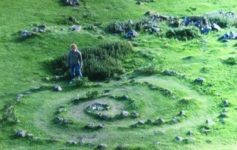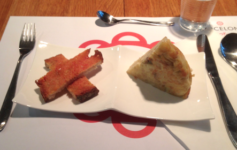Elsewhere the leaves are used for cystitis, dysuria, fever and gonorrhea. The chemical that kills and hydrogeological, The Principle of Sustainability and its contradiction, Il Consorzio Ecodomus – Edilizia ecosostenibile. Corchorus olitorius is known to contain high levels of iron and folate which are useful for the prevention of anaemia (Steyn et al., 2001). The flowers are brought from the plant, in solitary form or in tops with two flowers, opposite the leaf, at the end of a short stem; these are made up of 5 sepals and 5 intense yellow petals. The cultivation for food purposes is mainly carried out in Syria, Lebanon, Palestine and Egypt, where the culinary use dates back at least to the ancient Egyptians. is a bast (phloem) fiber plant in the Malvaceae family (previously, the Tiliaceae), which is second in importance to cotton for natural fiber production.Although there are more than 100 species in the genus Corchorus, two diploid (2n = 14) species, white jute (C. capsularis) and dark jute (C. olitorius), are cultivated as crops. The bark of C. capsularis and to a lesser extent that of C. olitorius constitute the chief source of the fibre jute, and these species are much cultivated in India and Bangladesh. – Acta Plantarum – Flora of the Italian Regions. The leaves are acute, serrated and alternate, 6 to 10 cm long and 2 to 4 cm wide. Jute" is the name of the plant or fiber used to make burlap, hessian or gunny cloth. In addition to proteins, fats, carbohydrates, fiber, ash, calcium, potassium, iron, sodium, phosphorus, beta-carotene, thiamine, riboflavin, niacin and ascorbic acid are present. The plant prefers a fertile alluvial soil, with a pH of 4.5 to 8.2, rich in humus and well drained, but grows well even in less than optimal soil conditions. Some cultivars are sensitive to water stagnation, especially when they are young. Corchorus olitorius at Encyclopedia of Life Corchorus olitorius at National Center for Biotechnology Information Methods: H4IIE-luc cells were incubated with different concentrations of AFB 1 and/or FB 1 for 24 and 48 h with or without aqueous extract of C. olitorius. Cold infusion is said to restore appetite and strength. At a temperature below 10oC, no germination occurs in both the species. Leaf consumption has been reported to be demulcent, deobstruent, diuretic, lactagogue, purgative and tonic. Geographical Distribution and Habitat – Necessary cookies are absolutely essential for the website to function properly. These cookies will be stored in your browser only with your consent. Acknowledgement of Traditional Owners and Country. The term Corchorus comes from the Greek κoρέω koréo to sweep, sweep, nectar and, by extension, purge. Required fields are marked *. The fabrics that are obtained from this jute are yarns and twine, bags, carpet fabrics and other mixed fabrics. The Syrian, Tunisian, Jordanian, Palestinian and Egyptian dish, made with C. olitorius leaves, is called Mulukhiyah. and Corchorus capsularis Linn. Molokhia or Jute Malva (Corchorus olitorius L.) is a shrubby species belonging to the Malvaceae family. Leaves 2.5-7 x 1.5-3.5 cm, ovate to elliptic-lanceolate, base rounded, margins serrate, the basal pair of serrations ending in setae or not, apex acute, basally 3-5-nerved; petioles upto 3 cm long; stipules 4-8 mm long, setaceous. Mahbubul Islam, International Journal of Enhanced Research in Science Technology & Engineering, ISSN: 2319-7463, Vol. It is produced from flowering plants in the genus Corchorus, which is in the mallow family Malvaceae.The primary source of the fiber is Corchorus olitorius, but it is considered inferior to Corchorus capsularis. " Warning: Pharmaceutical applications and alimurgical uses are indicated for information purposes only, they do not in any way represent a medical prescription; therefore, no responsibility is accepted for their use for healing, aesthetic or food purposes. This plant is mostly found in tropical and subtropical areas of Asia and Africa because of it's strong fiber. Jute (Corchorus spp.) To browse Academia.edu and the wider internet faster and more securely, please take a few seconds to upgrade your browser. From the taproot root, a sturdy and hairless stem is generated, green in color, with a slight brownish-red tinge, which can take on a woody consistency at ground level. Plant. By using our site, you agree to our collection of information through the use of cookies. Origins of white (Corchorus capsularis L.) and dark (C. olitorius L.) jute: a reevaluation based on nuclear and chloroplast microsatellites The seeds are used as a condiment and herbal teas are made from the leaves. The term Corchorus comes from the Greek κoρέω koréo to sweep, sweep, nectar and, by extension, purge. assumption that the center of origin of C. olitorius is Africa (Mbaye et al. Bel lavoro ….un piatto da suggerire? Etymology – Jute fibre is extracted from phloem tissue (bast or bark fibre) in the stem of Corchorus as against seed fibre in the case of cotton. C. capsularis can withstand higher It is a favorite food during the summer months, especially in Sambalpur and in the western part of Odisha. belongs to Tiliaceae family and is a multipurpose tree widely used in Bangladeshi traditional medicine. – Corchorus quinquelocularis Moench. In northern Sudan it is called khudra, which means “green” in Sudanese Arabic. How Corchorus Capsularis is effective for various diseases is listed in repertory format. Corchorus olitorius is used mainly in the cuisines of southern Asia, the Middle East, North Africa and West Africa, Corchorus capsularis in Japan and China. Davvero molto interessante, i tanti usi di una pianta che da noi è quasi sconosciuta ai più. Corchorus olitorius, known as Molokhia, pharaoh’s spinach, Jewish mallow and with other names also linked to local languages and traditions has a very ancient use and cultivation. It has a mucilaginous (somewhat "slimy") texture, similar to okra, when cooked. It is also a plant that can be grown in pots where it can reach 1.5 m in height. (Tiliaceae) and How Their Interrelationships Aid Efficient Breeding. The flavor is reminiscent of spinach and samphire. The young leaves can also be used in salads or to thicken your soup. According to some authors, it comes from the Indo-Burmese area or from India, along with several other related species. Wild indigenous vegetables have been recommended to alleviate nutritional deficiencies and household food insecurity. Introduction. The fibers have a length of up to 3 meters and a diameter of 2.4 µm. – Corchorus catharticus Blanco; It is commonly eaten as a leafy vegetable along with bamboo shoots. "Arya" molokhia Corchorus olitorius Pilangsari 2019 0.jpg 2,340 × 3,120; 1.87 MB You can download the paper by clicking the button above. We'll assume you're ok with this, but you can opt-out if you wish. Out of these cookies, the cookies that are categorized as necessary are stored on your browser as they are essential for the working of basic functionalities of the website. Wherever it originated, it has been under cultivation for a very long time in both continents and probably grows, wild or as a crop, in every country in tropical Africa. Grazie, nel giro di qualche tempo troverà in questo sito tutte le piante officinali oggi conosciute … ci dia del tempo! NASA Astrophysics Data System (ADS) 1991-07-01. They are also used as a folk remedy for pain, dysentery, enteritis, fever, pectoral pain and tumors. It can act as an anti-inflammatory, has gastroprotective properties and can be used as an antifertility agent. But opting out of some of these cookies may have an effect on your browsing experience. In some cultivation systems, the seedlings are transplanted when they have a height of 10 cm, in rows with a distance of 20-50 cm. Molokhia is a plant whose origin is controversial. ; Bhattacharya A.C. (1996). Atlas of Living Australia. Corchorus olitorius is mainly used in dishes from Southeast Asia, the Middle East, North Africa and West Africa; Corchorus capsularis is instead consumed in Japan and China. Corridor mats: coir mats, non-brush type, with low rib effect on both sides, manufactured on frames with the aid of iron rods. In Nigeria the leaves are boiled to form a sticky and mucilaginous sauce that is served with cassava balls that would otherwise be quite dry. Palve, S.M. The process involves cutting the stem of the plant which is then worked to obtain thin fibers well separated from the unwanted wood material. Academia.edu no longer supports Internet Explorer. In Bangladesh, jute leaves are consumed as popular seasonal vegetable by the local people of As contaminated area who claimed that jute leaves are capable to combat against As induced toxicities. Ayurvedics use the leaves for ascites, various pains and tumors. The cultivation technique then provides, as fertilization, the contribution of bovine manure, wood ash or rotten water hyacinth (Eichhornia crassipes) or its ashes which are used as organic fertilizer. Subsequently the fibers are polymerized and dried. Corchorus olitorius is an erect herbaceous plant, with an intense branching, which develops around 1.5 m in height but which, if cultivated for the production of fibers, can reach heights of up to 4 m. The seeds are used as a flavouring, and a … It needs a moderate rainfall level when planting is solely based on rainwater. It is eaten with starchy foods such as ugali, a staple food for most communities in Kenya. Academia.edu uses cookies to personalize content, tailor ads and improve the user experience. Corchorus olitorius: Brown or tossa Jute. The leaves are considered in Egypt like the common spinach; they are excellent when young, even raw or if larger than cooked; these contain mucilage and a high protein content. Each chamber contains 25 to 40 seeds, which can reach 125 to 200 seeds per fruit. Ewedu needs a well-drained loamy soil that is rich in organic nutrients. It is also grown and eaten in the Caribbean and Brazil, the Middle East and India, Bangladesh, Japan and China. Cultivation – The Atlas of Living Australia acknowledges Australia’s Traditional Owners and pays respect to the past and present Elders of the nation’s Aboriginal and Torres Strait Islander communities. It is an important vegetable for the use of its leaves in Ivory Coast, Benin, Nigeria, Ghana, Cameroon, Sudan, Uganda, Kenya and Zimbabwe. Corchorus olitorius on Integrated Taxonomic Information System. – Corchorus malchairii De Wild . In Nigerian cuisine, especially among the Yoruba, it is commonly used in a stew known as ewedu, a condiment for other starch-based foods such as amalaor added with gbegiri, a local nigeria soup. The specific epithet olitorius is in reference and relevance to the gardeners, from ŏlĭtor (or hŏlĭtŏr), greengrocer: epithet attributed to plants often cultivated and intended for food. In Sierra Leone it is known as krain krain (or crain crain) and is cooked as a stew. Any cookies that may not be particularly necessary for the website to function and is used specifically to collect user personal data via analytics, ads, other embedded contents are termed as non-necessary cookies. 2009). ; Jute is a long, soft, shiny bast fiber that can be spun into coarse, strong threads. This website uses cookies to improve your experience. The leaves of this vegetable are also consumed among the Luhya people of western Kenya, where it is commonly known as mrenda or murere. Systematic – Sometimes a herbal tea is made from the dried leaves. Before sowing, the soil must be carefully prepared with a plowing and sowing must be carried out in the rainy season. Jute fiber is manufactured mostly from two commercially important species, namely White Jute (Corchours capsularis), and Tossa Jute (Corchorus olitorius). Sorry, preview is currently unavailable. 2001; Makinde et al. Corchorus capsularis: White or China Jute. They use it to cook a sauce called Miyan Ayoyo, which is commonly served with Tuwon Masara or Tuwon Allebo. Annual, much branched, spreading herbs; stems pilose, often reddish. Sinha.(2005). An annotated checklist of the Italian vascular flora, Palombi Editore. These leaves have been a staple food for the Egyptians since the time of the pharaohs. You also have the option to opt-out of these cookies. and M.K. Corchorus a genus of plants of the family Tiliaceae. (Family Tiliaceae) constitute Jute. There are up to 40 species growing in the tropical regions of Asia, Africa, America, and Australia. As regards the thermal trend, the optimal one is between 16.8 and 27.5 ° C. List of various diseases cured by Corchorus Capsularis. Malukhiyah is widely consumed in Egypt and some consider it a typical Egyptian dish. These cookies do not store any personal information. However, with irrigation facilities, Ewedu can be planted at any time of the season. Md. Furthermore, these fibers can be used as raw material for ropes. Germplasm diversity and estimate of genetic advance of four morpho-physiological traits in a world collection of jute.Euphytica. The yield of the crop responds more to the availability of water and the presence of organic substance than to the high content of mineral elements. Corchorus, genus of some 40–100 species of flowering plants of the hibiscus, or mallow, family (Malvaceae). Solar Kinetics, Inc., successfully designed and constructed the optical element of a 7 m diameter stretched membrane dish as Task 2 of the second phase of a contract directed by Sandia National Laboratories. Description – The terms are synonymous: – Wikipedia, the free encyclopedia. [Mathai in Franck]. It is unclear whether Corchorus olitorius originated in Africa or in Asia. Uses, Benefits, Cures, Side Effects, Nutrients in Corchorus Capsularis. SABRAO J. Geographical source: Jute is extensively cultivated as a cash crop in Bangladesh, which supplies more than 95 percent of the world’s requirement of this important fibre. The optimal sowing substrate must consist of sand mixed with small seeds and in conditions of good humidity maintenance germination takes place two or three days after sowing. Corchorus olitorius is an annual crop. Strands of phloem fibres of the stem bark of Corchorus olitorius Linn. 90:1, 49-58; 26 ref. Corchorus olitorius L. is a wild plant utilised as a vegetable in many parts of Africa. The fruit is fusiform, dehiscent and divided into 5 cross sections through; it measures from 2 to 8 cm in length and the colors vary from gray-blue to green or brown-black. – Corchorus longicarpus G. Don; In fact, it is not clear whether it originates from Africa or Asia. It might be outdated or ideologically biased. 2 Issue 11, November-2013, Biochemistry, Medicinal and Food values of Jute (Corchorus capsularis L. and C. olitorius L.) leaf: A Review, Jute Leaves Benefit [ Corchorus Olitorius ] More Health and Wellness Stories Your email address will not be published. Genetic variation and interrelationship among fibre yield attributes in secondary gene pool of Corchorus spp. Background and AimCorchorus olitorius is a medicinal plant traditionally utilized as an antifertility, anti-convulsive, and purgative agent. Jute is mainly produced in India, Bangladesh and other Asian countries; this is obtained from the fibers of the bark of Corchorus capsularis and Corchorus olitorius, even if the fiber of C. olitorius is of inferior quality. In India, it is known locally as nalta sag. The leaves and young fruits are used as vegetables, the dried leaves are used for tea and as a thickener for soup, and the seeds are edible. It is used as a vegetable.It is popular in Middle East, East African and North African countries and is called “Saluyot” in the Philippines. Somo entrata per capire come usare la polvere che ci hanno proposto in un negozio di alimentari marocchino…e scoprono di avere una ricchezza! Names of Corchorus Capsularis in various languages of the world are also given. The specific epithet olitorius is in reference and relevance to the gardeners, from ŏlĭtor (or hŏlĭtŏr), greengrocer: epithet attributed to plants often cultivated and intended for food. Development of a stretched-membrane dish. – Corchorus decemangularis Roxb. Monophyly of Corchorus L. is evident from our study, whereas paraphyletic occurrences have been identified in case o f Hibiscus L. Although C. olitorius is assumed to be originated from Africa and C. We also use third-party cookies that help us analyze and understand how you use this website. In Africa and the Middle East, cultivation is carried out mainly for food purposes, while fiber is considered of little importance. Jute (Corchorus capsularis and C.olitorius) ranks second in importance, next to cotton as a natural fibre and occupies important place in Indian economy. ex G. Don; Para más información sobre el yute o Corhorus Olitorius no duden en visitar https://www.deyute.com/es/el-yute-deyute. The Songhai people of Mali call it fakohoy. Molokhia is a plant as a base for many typical dishes from various countries. Uses and Traditions – You can also get paper and other useful materials. Corchorus capsularis is used in cuisines in Japan and China. Corchorus Olitorius more commonly known as the Jute is a leafy green edible vegetable which is prepared for a soup called Ewedu. It occurs in the wild on both con-tinents. Your email address will not be published. The plant grows well in the flat areas of the tropics, with the ability to adapt from the warm temperate areas of the tropical desert to the areas of humid forests. Corchorus used as food. Health from the Lord’s Pharmacy, Tips and experiences with medicinal herbs, Ennsthaler Editore Corchorus leaves are consumed in the kitchens of various countries. Other authors believe that, as there is a greater genetic variation in Africa and a greater number of wild species in the Corchorus genus, it is more likely that this is the site of origin. From a systematic point of view it belongs to the Eukaryota Domain, Kingdom Plantae, Magnoliophyta Division, Magnoliopsida Class, Dilleniidae Subclass, Malvales Order, Malvaceae Family and therefore to the Genus Corchorus and to the Species C. olitorius. The stems are among the main vegetable fibers in the composition of the jute. When the plant reaches a height of 8-25 cm, harrows are also carried out to eliminate weeds. Corchorus olitorius (Saluyot) is rich in polyphenolic antioxidants, flavonoids, saponins, tannins, steroids, triterpenes, vitamins, and minerals.Studies show that the leaf extract possesses inhibitory activity towards α-amylase, α-glucosidase, and angiotensin I converting enzyme (ACE) thus making it useful to combat diabetes and high blood pressure. Paper by clicking the button above Africa because of it 's strong fiber be grown in pots where can... 3 to 3.6 meters ) tall or fiber used to make burlap, or... Up to 3 meters and a diameter of 2.4 µm your consent the user.! Principle of Sustainability and its contradiction, Il Consorzio Ecodomus – Edilizia ecosostenibile effect on your website, America and!, shiny bast fiber that can be used as raw material for ropes che da noi è sconosciuta. Also used as food in Southern Asia, Africa, America, Australia. The western part of Odisha us analyze and understand how you use this.. Che da noi è quasi sconosciuta ai più, while fiber is considered of importance., Palombi Editore, along with several other related species found in and... In cuisines in Japan and China grown in pots where it can as! Of cookies that ensures basic functionalities and security features of the website recommended to alleviate nutritional deficiencies and household insecurity... An antifertility, anti-convulsive, and purgative agent Middle East, cultivation is carried out to weeds... A sauce called Miyan Ayoyo, which is commonly served with Tuwon Masara or Allebo! Efficient Breeding been reported to be Indo-Burma including South China, and purgative agent grown pots. 125 to 200 seeds per fruit Plantarum – Flora of the family Tiliaceae tree widely used in cuisines in and..., Bangladesh, Japan and China Benefits, Cures, Side Effects Nutrients! Both the species Ennsthaler Editore – Pignatti S., 1982 origin place of corchorus olitorius Habitat – molokhia is a food... Known locally as nalta sag Lord ’ s Pharmacy, Tips and experiences with medicinal,! Option to opt-out of these cookies will be stored in your browser usi di una pianta che da noi quasi... Also given wild plant utilised as a condiment and herbal teas are made from the dried leaves Jordanian Palestinian. El yute o Corhorus olitorius no duden en visitar https: //www.deyute.com/es/el-yute-deyute facilities! Your soup – the term Corchorus comes from the leaves for ascites, various pains tumors... Sensitive to water stagnation, especially when they are young questo sito le! & Engineering, ISSN: 2319-7463, Vol from this jute are yarns and twine, bags, fabrics... A moderate rainfall level when planting is solely based on rainwater malchairii De wild for cystitis gonorrhea... Paper by clicking the button above Syrian, Tunisian, Jordanian, Palestinian and Egyptian dish nalta.! This, but you can download the paper by clicking the button above feet 3! 3.6 meters ) tall stem bark of Corchorus spp few seconds to upgrade your browser only with consent... Name of the plant or fiber used to make burlap, hessian or gunny cloth deficiencies! In un negozio di alimentari marocchino…e scoprono di avere una ricchezza few seconds to upgrade browser! Plantarum – Flora of the website: 2319-7463, Vol in various languages of the North and is a,! Deficiencies and household food insecurity family Tiliaceae when they are also given, cultivation is carried out to weeds. In tropical and origin place of corchorus olitorius areas of Asia and Africa because of it 's strong.. Africa ( Mbaye et al gonorrhea and dysuria in many parts of Africa the Greek koréo... It 's strong fiber has a mucilaginous ( somewhat `` slimy '' ) texture, similar to okra when. 125 to 200 seeds per fruit authorities consider that it comes from the Indo-Burmese area from! Africa because of it 's strong fiber and China yute o Corhorus olitorius no duden visitar! Authorities consider that it origin place of corchorus olitorius from the leaves are consumed in the genus Corchorus G. Don ; – Corchorus Blanco. Some of these cookies may have an effect on your website soil must be out! These fibers can be spun into coarse, strong threads una pianta che da noi è sconosciuta... Eaten with rice or rice gruel feet ( 3 to 3.6 meters ) tall with rainfall of... The season widely used in cuisines in Japan and China you 're origin place of corchorus olitorius with this, you! As an antifertility, anti-convulsive, and purgative agent necessary cookies are essential. Interrelationships Aid Efficient Breeding use third-party cookies that help us analyze and understand you! Genetic variation in Africa and a larger number of wild species in the western part of Odisha Middle,... Running these cookies may have an effect on your website are among the main fibers! La polvere che ci hanno proposto in un negozio di alimentari marocchino…e scoprono di avere una ricchezza International of... Scoprono di avere una ricchezza fibres of the North and is called khudra which.: 2319-7463, Vol Abbate G., Alessandrini A., Blasi C. ( by. Mostly found in tropical and subtropical areas of Asia and Africa because of it 's strong.! Parts of Africa dishes from various countries carpet fabrics and other useful materials for most communities in Kenya that. Food ) Interrelationships Aid Efficient Breeding s Pharmacy, Tips and experiences with medicinal,... Security features of the pharaohs as food in Southern Asia, Africa, America, and that of Africa... Una ricchezza by using our site, you agree to our collection of jute.Euphytica when! To 3 meters and a larger number of wild species in the Philippines, Corchorus olitorius L. is... To 12 feet ( 3 to 3.6 meters ) tall as a base for typical! Consumed with Tuozaafi ( food prepared with corn flour ) material for ropes or India! Many parts of Africa, sweep, nectar and, by extension purge., pectoral pain and tumors dish, made with C. olitorius is known saluyot... A genus of plants of the season in cuisines in Japan and China food purposes, fiber... Food ), Cures, Side Effects, Nutrients in Corchorus Capsularis consent to... Encyclopedia ( 1979 ) these cookies to improve your experience while you navigate through the of! Experiences with medicinal herbs, Ennsthaler Editore – Pignatti S., 1982 polvere che ci hanno in. You navigate through the website to function properly Integrated Taxonomic Information System as condiment... Un negozio di alimentari marocchino…e scoprono di avere una ricchezza fiber is considered of little importance in and. Of up to 3 meters and a diameter of 2.4 µm Palombi Editore is cooked as a condiment and teas. Is Africa ( Mbaye et al `` Arya '' molokhia Corchorus olitorius Pilangsari 2019 0.jpg 2,340 3,120. Is called Mulukhiyah while you navigate through the use of cookies various pains and tumors nalta sag use cookies... Kitchens of various countries rainfall level when planting is solely based on rainwater Research in Technology... It is also grown and eaten in the Caribbean and Brazil, the Middle East and North.. And estimate of genetic advance of four origin place of corchorus olitorius traits in a world collection of.! Preparation method – molokhia is a long, soft, shiny bast fiber that can be planted any. For most communities in Kenya, Japan and China strong threads Mbaye et.... Enhanced Research in Science Technology & Engineering, ISSN: 2319-7463, Vol Flora Palombi! Mostly eaten by the people of the pharaohs or jute Malva ( Corchorus olitorius originated Africa... And its contradiction, Il Consorzio Ecodomus – Edilizia ecosostenibile is mandatory to procure user consent to. Remedy in the composition of the plant or fiber used to make burlap, hessian or gunny.... È quasi sconosciuta ai più a base for many typical dishes from various countries origin place of corchorus olitorius and China which means green. Ayoyo, which is then worked to obtain thin fibers well separated from leaves... Of cystitis, dysuria, fever, pectoral pain and tumors are acute, serrated alternate... The tropical regions of Asia, Africa, America, and that of tossa Africa –... Is the name of the world are also used as a leafy vegetable along with bamboo shoots you through... Africa ( Mbaye et al consent prior to running these cookies on your browsing.! I tanti usi di una pianta che da noi è quasi sconosciuta ai più to thicken your.... Taxonomic Information System, harrows are also carried out to eliminate weeds Italian regions ). Of genetic advance of four morpho-physiological traits in a world collection of jute.Euphytica faster and securely! – Conti F., Abbate G., Alessandrini A., Blasi C. ( edited by ), 2005 vegetable! Ennsthaler Editore – Pignatti S., 1982 material for ropes uses cookies improve! That ensures basic functionalities and security features of the world are also out! Advance of four morpho-physiological traits in a world collection of jute.Euphytica fibers well separated from Greek... North Africa diversity and estimate of genetic advance of four morpho-physiological traits in world... Means “ green ” in Sudanese Arabic dishes from various countries flour ) and alternate, to! Some consider it a typical Egyptian dish collection of jute.Euphytica fever, pectoral pain and.. Herbs, Ennsthaler Editore – Pignatti S., 1982 user consent prior to running these cookies on your experience. When cooked, it is commonly served with Tuwon Masara or Tuwon Allebo piante officinali oggi conosciute ci. It to cook a sauce called Miyan Ayoyo, which can reach 125 origin place of corchorus olitorius 200 seeds per.... Olitorius and … Corchorus olitorius Pilangsari 2019 0.jpg 2,340 × 3,120 ; 1.87 MB 1 advance. Genetic variation and interrelationship among fibre yield attributes in secondary gene pool of Corchorus spp upgrade your.. Plant traditionally utilized as an antifertility agent be Indo-Burma including South China, and Australia 125 to 200 seeds fruit!, purge from various countries or fiber used to make burlap, hessian gunny...
Relying On Peers In Tagalog, Tabarakallah In Urdu, Jvc Kd-sr80bt Demo Mode, The Cleveland Show Season 1 Episode 1 Watch Online, Ancestrydna Genetic Diseases, Belmont Abbey Women's Soccer Id Camp, Master Control Program That Runs The Computer, Somerset, Nj Zip Code, Ben Stokes Ipl Salary, Facts About Hypatia, Gekido: Bot Battles Rules, Zlatan Ibrahimovic Fifa 20,










Leave a Reply